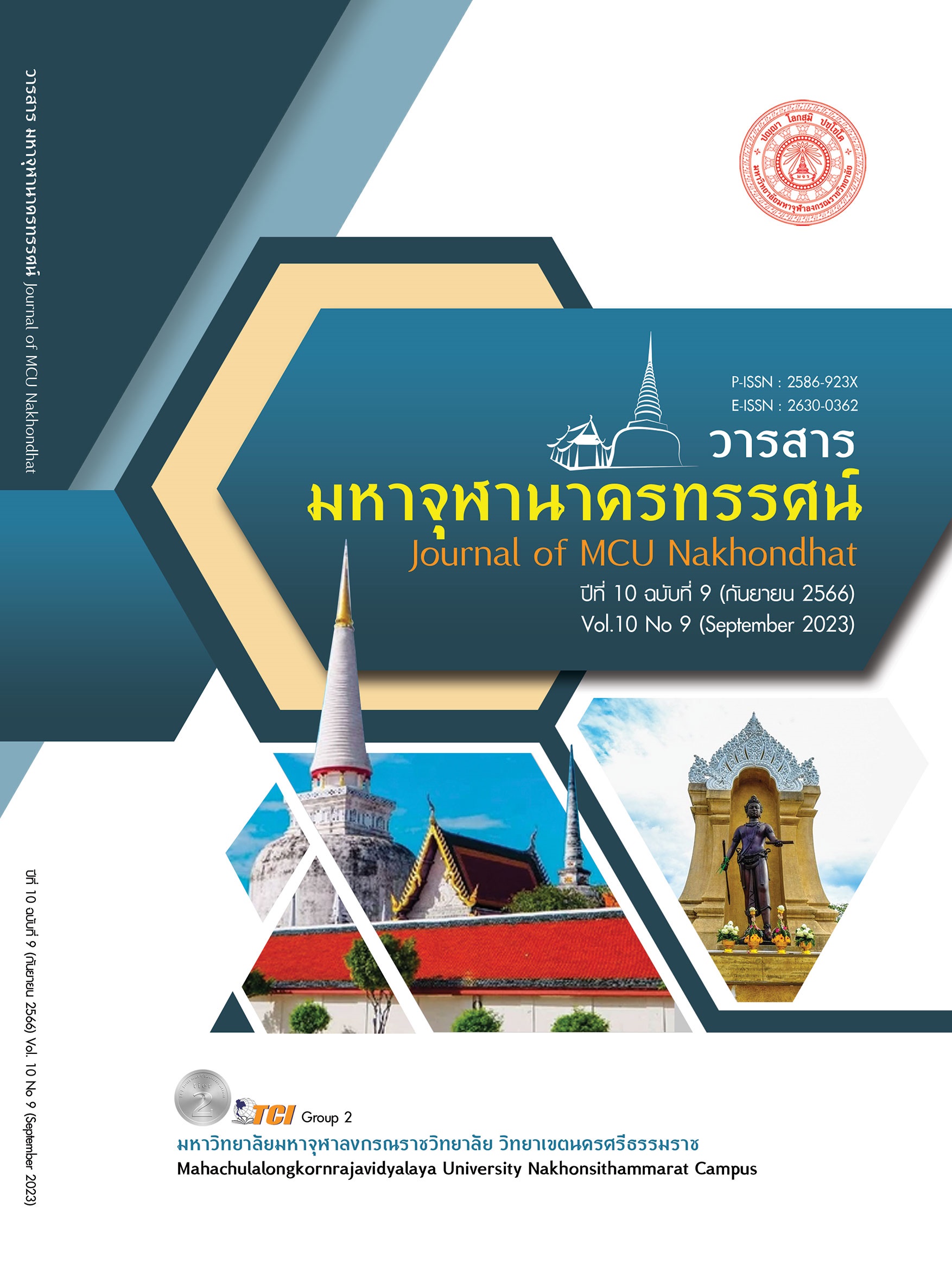INVESTIGATING COMPONENTS OF THE COMPETENCY - BASED CURRICULUM DEVELOPMENT USING PDSA AND SINGLE LOOP LEARNING CONCEPTS FOR STAND - ALONE SCHOOLS
Main Article Content
Abstract
This article was to study the components and indicators of competency - based curriculum development using Plan - Do - Study - Act (PDSA) and Single Loop Learning concepts for stand alone schools under the Office of the Basic Education Commission (OBEC). The research was carried out using the mixed method research that combines and integrates qualitative and quantitative research methods, including studying and analyzing related documents and research, collecting data from schools that provide competency -based education, synthesizing components and indicators, and analyzing the components and indicators by a confirmatory factor analysis (CFA). It was found that there are 4 components with 25 indicators that are consistent with the empirical data with a Chi - square (χ2) of 559.36 at a degree of freedom (df) of 144, which can be calculated to a relative Chi - square of 2.31, a comparative fit index (CFI) of 0.99, a root mean square error of approximation (RMSEA) of 0.07, and a standardized root mean square residual (SRMR) of 0.04. The significance of the components can be ordered according to the completely standardized solution (CS) values as follows; ACT: Summary of the results and promulgate the competency - based school curriculum (CS = 0.99), DO: Prepare for developing curriculum and course structures (CS = 0.98), STUDY: Implement the draft competency - based school curriculum to teaching and learning (CS = 0.95), and PLAN: Set goals for developing a competency - based school curriculum (CS = 0.94), respectively. With all components and indicators taken into account, it can be concluded that school administrators should take a leading role in empowering teachers, school personnel, and communities to provide education that prepares students to face challenges in the future.
Article Details

This work is licensed under a Creative Commons Attribution-NonCommercial-NoDerivatives 4.0 International License.
References
ทรงพล เทพคำ. (2557). การพัฒนาสมรรถนะผู้บริหารสถานศึกษาสังกัดสำนักงานคณะกรรมการการศึกษาขั้นพื้นฐานในภาคเหนือตอนบน. วารสารสังคมศาสตร์วิชาการ, 7(1), 114 - 130.
รวีวรรณ ต๊ะถิ่น และคณะ. (2558). แนวทางพัฒนาการบริหารจัดการหลักสูตรระดับสถานศึกษาของโรงเรียนที่เข้าร่วมโครงการ นาร่องการใช้หลักสูตรแกนกลางการศึกษาขั้นพื้นฐาน พุทธศักราช 2551 สังกัดสำนักงานเขตพื้นที่การศึกษาประถมศึกษาตาก เขต 2. วารสารมนุษยศาสตร์และสังคมศาสตร์, 21(3), 230 - 240.
ระเบียบบริหารราชการกระทรวงศึกษาธิการ 2546. (2546). ราชกิจจานุเบกษา เล่ม 120 ตอนที่ 62 ก หน้า 1 (6 กรกฎาคม 2546).
วิชัย วงษ์ใหญ่. (2550). ผู้เรียนเป็นสำคัญ. ใน สารานุกรมวิชาชีพครูเฉลิมพระเกียรติพระบาทสมเด็จพระเจ้าอยู่หัว เนื่องในโอกาสฉลองสิริราชสมบัติครบ 60 ปี. กรุงเทพมหานคร: สำนักงานเลขาธิการคุรุสภา.
วิชัย วงใหญ่ และมารุต พัฒผล. (2558). จากหลักสูตรแกนกลางสู่หลักสูตรสถานศึกษา กระบวนทัศน์ใหม่การพัฒนา (พิมพ์ครั้งที่ 8). กรุงเทพมหานคร: บริษัท จรัลสนิทวงศ์การพิมพ์ จำกัด.
สถาบันส่งเสริมการสอนวิทยาศาสตร์และเทคโนโลยี. (2566). ผลการประเมิน PISA. เรียกใช้เมื่อ 28 พฤษภาคม 2566 จาก https://pisathailand.ipst.ac.th/pisa2000 - pisa2018/
สมพร บัวกล่ำธนกิจ และคณะ. (2562). ทักษะครูในศตวรรษที่ 21 ที่ส่งผลต่อการเป็นชุมชนการเรียนรู้ทางวิชาชีพของครูผู้สอนในโรงเรียนที่สอนนักเรียนที่มีความบกพร่องทางการได้ยิน. วิจัยและประเมินผลอุบลราชธานี, 8(1), 50 - 59.
สำนักงานปลัดกระทรวงศึกษาธิการ. (2565). รู้จักกับ โครงการโรงเรียนคุณภาพ ตามนโยบาย รมว.ศธ. ตรีนุช เทียนทอง. เรียกใช้เมื่อ 28 พฤษภาคม 2566 จาก https://moe360.blog/2022/05/25/
สำนักงานเลขาธิการสภาการศึกษา. (2561). มาตรฐานการศึกษาของชาติ พ.ศ. 2561. กรุงเทพมหานคร: สำนักงานเลขาธิการสภาการศึกษา.
สำนักงานเลขาธิการสภาการศึกษา. (2562). เข้าใจสมรรถนะอย่างง่าย ๆ ฉบับประชาชน และเข้าใจหลักสูตรฐานสมรรถนะอย่างง่าย ๆ ฉบับครู ผู้บริหาร และบุคลากรทางการศึกษา (พิมพ์ครั้งที่ 1). กรุงเทพมหานคร: สำนักงานเลขาธิการสภาการศึกษา.
สิริพัชร์ เจษฎาวิโรจน์. (2548). การพัฒนาหลักสูตรสถานศึกษา. กรุงเทพมหานคร: สำนักพิมพ์มหาวิทยาลัยรามคำแหง.
สุกัญญา แช่มช้อย. (2555). การบริหารโดยสถานศึกษาและชุมชนเป็นฐาน : ความท้าทายของการปฏิรูปการศึกษาในทศวรรษที่สอง. วารสารศึกษาศาสตร์ มหาวิทยาลัยนเรศวร, 14(1), 101 - 110.
Adegbemile, O. (2011). Principals’ Competency Needs for Effective Schools’ Administration in Nigeria. Journal of Education and Practice, 2(4), 15 - 23.
Albanese, R. (2005). Competency-Based Management Education: Three Operative and Normative Issues. Journal of Management Education, 14(1), 16 - 28.
Bentler, P. M. (1990). Comparative Fit Indexes in Structural Models. Psychological Bulletin, 170(2), 238 - 246.
Buttram, J. L. & Farley-Ripple, E. N. (2016). The Role of Principals in Professional Learning Communities. Leadership and Policy in Schools, 15(2), 192 - 220.
Kline, R. B. (1998). Principles and Practice of Structural Equation Modeling. New York: Guilford Press.
Krejcie, R. V. & Morgan, D. W. (1970). Determining sample size for research activities. Educational and Psychological Measurement, 30(3), 607 - 610.
Whitney, A. E. (2013). When University Faculty Nurture Teacher Leadership: “Horizontal” Practices and Values in a Professor’s Work with Teachers. International Journal of Leadership in Education, 16(1), 71 - 93.


